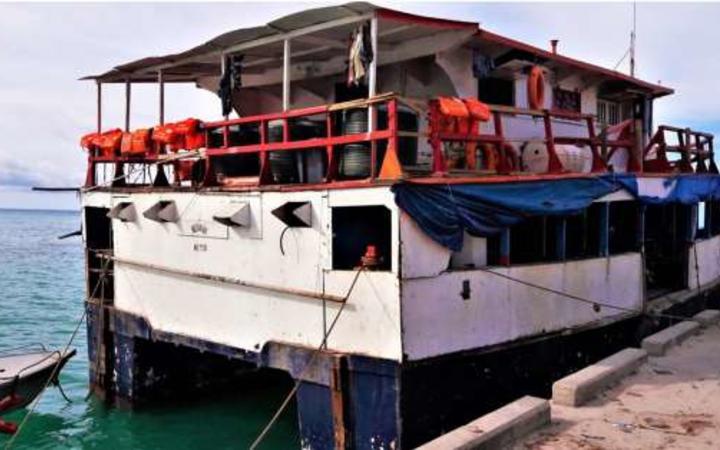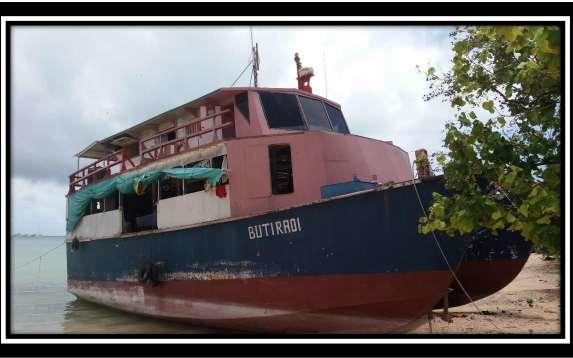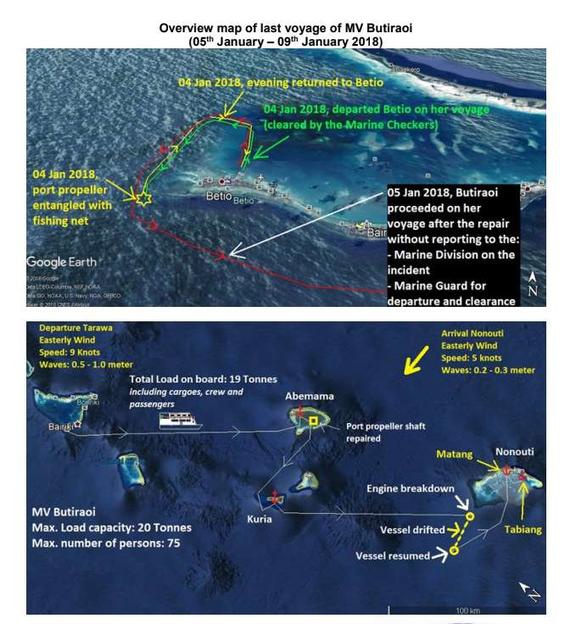Litany of failures led to Kiribati ferry tragedy - inquiry report
Jamie Tahana, RNZ Pacific Journalist
A ship that sank in Kiribati last year, killing 95 people, was severely overloaded, unauthorised to carry passengers, had no emergency beacon, not enough life jackets, and was also commanded by a captain who ignored several warnings on the day of the tragedy.

The MV Butiraoi was severely overloaded and structurally compromised when it sank in 2018. Photo: Supplied / Government of Kiribati
Those conclusions are detailed in a report by the Commission of Inquiry into the sinking of the MV Butiraoi, which details a litany of failures that led to the country's worst maritime disaster.
The report was released by the office of the president, Taneti Maamau, on Monday. Until then, it had only been available in hard copy at the president's office or the national library, a move which had been criticised as secretive and undemocratic, with reports of time restrictions and a ban on copying, photographing or taking notes from the report.
The full version has now finally been released to overseas media - including RNZ Pacific.
The following account of the disaster is based on the Commission of Inquiry's final report, a separate report compiled by the Kiribati Marine Division Investigation Team (which was also released this week), and interviews conducted last week by RNZ Pacific with two people familiar with the report's findings.
Mr Maamau's office has so far not responded to a request for an interview.
The journey
The Butiraoi, a 17-metre wooden catamaran, left the island of Nonouti on the morning of 18 January, 2018.
It had left the main island, Tarawa, a week earlier, laden with fuel for islands including Nonouti, where supplies were running out. Authorities had prohibited it from carrying any passengers, but when it left Nonouti on that fateful Thursday morning, there were 89 passengers and 13 crew on board.
The already overloaded ship was also packed with 29.5 tonnes of cargo - 537 bags, a load of copra, a motorbike, and 35 empty fuel drums. Before it left the wharf, the ship's captain, who is not named by the report, was warned of severe weather affecting much of Kiribati. The country's meteorological service had warned of both strong winds and swells as high as three metres.
The captain decided to set sail anyway, without telling the marine guard at Nonouti. As it left the shelter of the lagoon, entering the treacherous seas of the open Pacific, the Butiraoi started to creak, according to testimony from the surviving passengers and crew, who said it was pitching, pounding and listing heavily. The captain also turned off the generator that powered the ship's radio communication system, they said.

The MV Butiraoi, a 17-metre wooden catamaran, which sank in Kiribati in January 2018. Photo: Supplied / Government of Kiribati
The reports said that after only 30 minutes at sea, the main cross beam which held the catamaran's two hulls together failed, unleashing two loud noises. Still, the captain did nothing, refusing to turn back or slow down. After three hours, the ferry collapsed in on itself, the cabin and wheelhouse tumbling in between the hulls. From there, panic ensued as it sank rapidly.
The Butiraoi only had enough life jackets for about 30 people, the report said, and was only equipped with two inflatable life rafts and two aluminium dinghies - nowhere near enough for the 102 people on board.
Passengers helped the crew launch the boats from the rapidly sinking ship, but one of the lifeboats punctured on the wreckage. Dozens of people then scrambled for the second life raft, but the floor on that failed, leaving only the inflated side tubes for desperate passengers to cling to. About 30 people - mostly women and children - were helped into the aluminium dinghies, with several more clinging to the sides.
Faced with disaster, the report said, the captain failed to step up to his task. According to the testimony, he did not lead the evacuation or give orders. Instead, it said, he was seen sitting on one of the capsized hulls as passengers screamed for help in a state described as dazed, regretful and sorry. He went down with the ship.
"The crew were not performing as expected," the report said. "It appeared that everyone was fighting for his or her own life."
While the Butiraoi sank not far from Nonouti, with more than 100 people fighting and scrambling for their lives, no one was aware. No distress message was sent from the foundering ship, the inquiry said, and an emergency locator beacon was not activated or did not work.
With no help on the horizon, the remaining passengers - about 30 of them - managed to tie the aluminium dinghies together, but the currents and rough swells set them drifting away from Nonouti into the open seas. After three days - with no help coming - one of the two rafts capsized in the middle of the night. In the panic, one of the crew managed to cut the rope connecting the two boats, preventing them both from sinking.
For days they were adrift in the searing sun of the Pacific. They had little food and no water, and one by one the remaining passengers started to perish. Each one who didn't make it cast overboard.
After seven days, people on land finally started to register that the Butiraoi was missing. The journey from Nanouti to Tarawa is one that usually takes two days.
The alert came via email, the Marine Division report said. The vessel's operator had got in touch with the mayor of Nonouti, asking if a search and rescue operation could be mounted. When the department checked its records, the Butiraoi was supposed to be in port at Betio, Tarawa. Its last contact with the marine guard was on 4 January, when it encountered propeller problems.
After a series of meetings, a search and rescue operation was finally mounted on 26 January, eight days after the Butiraoi sank. An urgent alert was sent to the rescue coordination centre in New Zealand, and an Air Force Orion plane was deployed to Kiribati, arriving on 27 January.
The search and rescue personnel had little information to go off. Throughout its journey, the Butiraoi had never reported its location, there had been no distress calls, no locator beacon signal. The best they had was a guess, but with nothing to pinpoint, the search area would be huge. They had no idea when the ship had sunk. In any case, the ocean's currents would have dragged any lifeboats or debris across dozens of kilometres by now.
But on the 28th of January, there was a miracle when a grainy picture emerged from the Orion. Seven people waving frantically from an aluminium dinghy in the central Pacific. Of the 102 people on board the Butiraoi, seven had survived.
Unseaworthy
What the report makes clear is that the MV Butiraoi should never have been allowed to set sail. It was not allowed to carry passengers, it had run aground twice before its fatal journey, and its radio licence had expired, essentially making it unseaworthy.
Its captain and crew had drunk alcohol during work hours, the generator that powered the radio had been turned off, and he refused to turn around when trouble hit. The two reports and interviews laid clear a callous disregard for rules and safety, that ended in what the Commission of Inquiry called a journey that "ended in the loss of so many lives the likes of which had never been witnessed in the maritime history of Kiribati."
The 17-metre wooden catamaran was built for the government in 2010. It was owned by the Abemama Island Council but leased to a company called TOKs Holding Co Ltd, which was responsible for all maintenance and repair work. (RNZ has approached both organisations for comment).
Its radio licence, which forms an integral part of its seaworthiness, had also expired on 1 January.
On its final journey from Tarawa to Abemama, then to Nonouti, the Butiraoi ran aground three times. It left Tarawa but became ensnared in a fishing net, which caused a mechanical failure. It then returned to Tarawa for repairs, leaving again the day after. The captain did not report that the repairs were completed, nor did it ask for clearance from the marine guard.

This
map, prepared by the Kiribati Maritime
Division, details
the final journey
of the MV Butiraoi.
Photo:
Supplied / Government of Kiribati
These repeated groundings, the reports said, would have seriously compromised the ship's overall structure.
"The grounding of the ship plus the overloading of passengers and cargoes showed that the master and his crew were not concerned with the safety of passengers at all," the Commission of Inquiry said.
The commission placed a lot of the blame on the ship's operator and captain, saying that the Butiraoi was not regularly maintained and shortcuts were taken. In a 2017 inspection, it said, the operator had borrowed a locator beacon from a pilot boat for the sole purpose of passing a survey.
It said the captain and crew were under-qualified and that they should not have been allowed to be in charge after previous groundings. It also found that the use of alcohol during working hours gave "the drunken crew the feeling of grandeur and power to make decisions alone".
The captain ignored repeated warnings in setting out on the fateful journey, and "it was obvious the master of the MV Butiraoi was reckless and inconsiderate of the ship, crew and passengers," it said.
"Interestingly, the operator of MV Butiraoi continued to allow that master to man his ship despite his records of previous groundings of his ship under his command."
While a lot of the blame is put on the captain, crew and owners, the inquiry also recommended the government tighten its regulatory procedures. It recommended that the government implemented ship building guidelines and oversight, a reporting mechanism for damage, and code of ethics among seafarers.
It also suggested a monument be constructed for "maintaining and nurturing the memory of our loved ones".



 Gordon Campbell: On When Racism Comes Disguised As Anti-racism
Gordon Campbell: On When Racism Comes Disguised As Anti-racism Peter Dunne: Newshub And TVNZ Tip Of Media Iceberg
Peter Dunne: Newshub And TVNZ Tip Of Media Iceberg Harry Finch: Austerity – For And Against
Harry Finch: Austerity – For And Against Gordon Campbell: On Winston Peters’ Pathetic Speech At The UN
Gordon Campbell: On Winston Peters’ Pathetic Speech At The UN Binoy Kampmark: Flicker Of Hope, Biden’s Throwaway Lines On Assange
Binoy Kampmark: Flicker Of Hope, Biden’s Throwaway Lines On Assange Media Matters NZ: Here We Go Again
Media Matters NZ: Here We Go Again